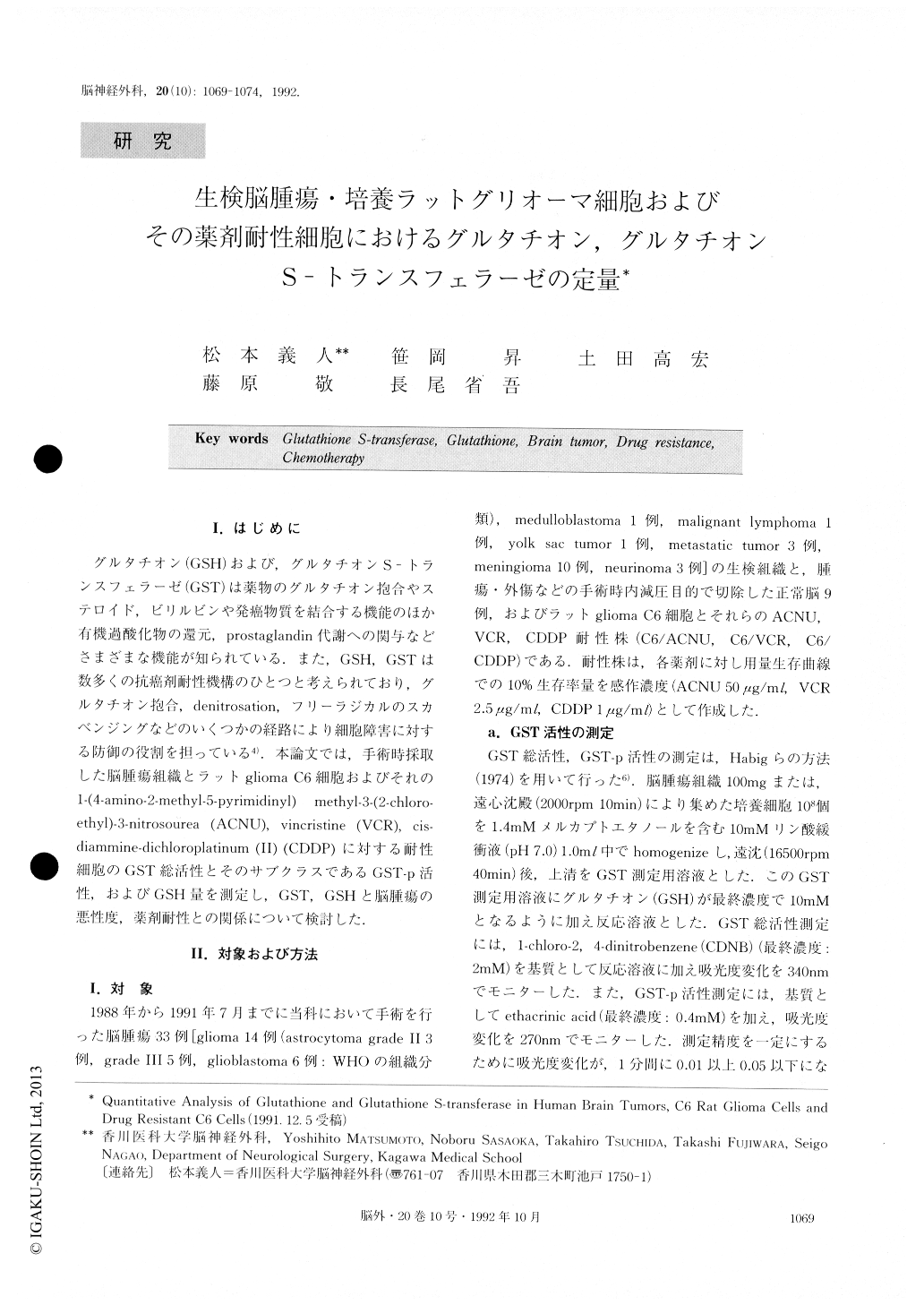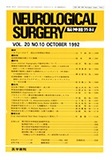Japanese
English
- 有料閲覧
- Abstract 文献概要
- 1ページ目 Look Inside
I.はじめに
グルタチオン(GSH)および,グルタチオンS—トランスフェラーゼ(GST)は薬物のグルタチオン抱合やステロイド,ビリルビンや発癌物質を結合する機能のほか有機過酸化物の還元,prostaglandin代謝への関与などさまざまな機能が知られている.また,GSH,GSTは数多くの抗癌剤耐性才幾構のひとつと考えられており,グルタチオン抱合,denitrosation,フリーラジカルのスカベンジングなどのいくつかの経路により細胞障害に対する防御の役割を担っている4).本論文では,手術時採取した脳腫瘍組織とラットglioma C6細胞およびそれの1—(4—amino−2—methyl−5—pyrimidinyl)methyl−3—(2—chloro—ethyl)−3—nitrosourea(ACNU),vincristine(VCR),cis—diammine-dichloroplatinum(II)(CDDP)に対する耐性細胞のGST総活性とそのサブクラスであるGST-p活性,およびGSH量を測定し,GST,GSHと脳腫瘍の悪性度,薬剤耐性との関係について検討した.
Glutathione (GSH) and Glutathione S-transferase (GST) plays an important role in the protection of cells against damage from free radicals and also influences cytotoxity to some kinds of chemotherapeutic agents. GST comprises a group of abundant and widely distri-buted catalytic and binding proteins that facilitate the conjugation of GSH with the electrophilic center of a large spectrum of hydrophilic molecules. Multiple GST isozymes in mammalian tissues arise from dimeric com-bination of a number of distinct subunits grouped into three major classes: a (alpha), (mu), and 2r (p). We re-port the total GST, GST-p activity and GSH content of human brain tumors, C6 rat glioma cells and drug resis-tant C6 cells.
The values of total GST activity in 42 normal brain and brain tumors were quantitatively analyzed. Total GST activity was 92.6±25.1 units (mean±standard devia-tion) in 8 samples of normal brain tissues, 126±58.8 un-its in five grade II or III astrocytomas (154±63.3 units in grade II astrocytomas, 84.4±2.7 units in 2 grade III astrocytoma), 66.2±29.3 in 5 glioblastoma cases, 94.7±47.7 units in 3 metastatic tumors, 302±114 unit in 8 meningiomas and 213±90.4 units in 3 neurinomas. Dif-ferences of GST activity between glioblastomas and meningiomas, grade II or III astrocytomas and mening-ioma, in normal brain tissues and meningioma were sta-tistically significant (p <0.01). The difference between normal brain tissues and benign tumors (meningiomas and neurinomas), gliomas and benign tumors were also statistically significant (p <0.05). Medulloblastoma, malignant lymphoma and yolk sac tumor showed low GST activity: 46.8, 101 and 71.5 units, respectively. Gliomas showed low GST activity. Especially in glio-blastomas, GST activity was extremely low. In contrast, meningiomas and neurinomas had high GST activity. These data suggest that total GST activity may serve as a novel marker to predict the sensitivity of brain tumors to radiotherapy and chemotherapy.
The values of total GST, GST-p and GSH in C6 cells and 1-(4-amino-2-methyl-3-(2-chloroethyl)-3-nitrosourea hydrochloride (ACNU), vincristine (VCR) and cisplatin (CDDP) resistant C6 cells were measured. C6/VCR and C6/CDDP cells exhibited 2.2-2.8 fold higher GST activ-ity and 1.8 fold higher GST-p activity than C6 cells. But there was no difference in total GST and GST-p activity between C6/ACNU and C6 cells. The GSH content of C6, C6/ACNU, C6/VCR and C6/CDDP were 23.1, 47.3, 167 and 83 (nmol/mg protein), respectively. Drug resis-tant cells, especially C6/VCR and C6/CDDP, were high-er in GSH content than C6 cells. Thus, resistance to drugs, especially VCR and CDDP, will be reflected by elevation of GST and GSH values.

Copyright © 1992, Igaku-Shoin Ltd. All rights reserved.


